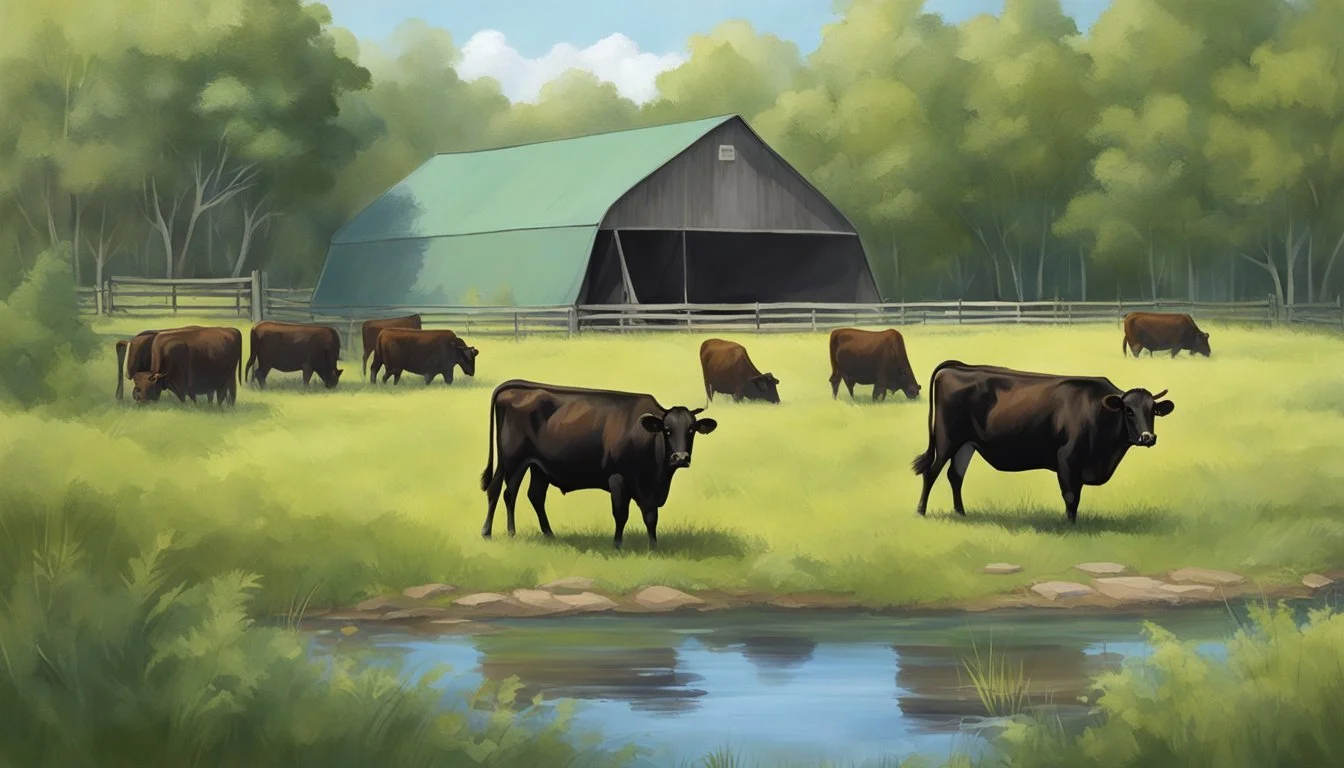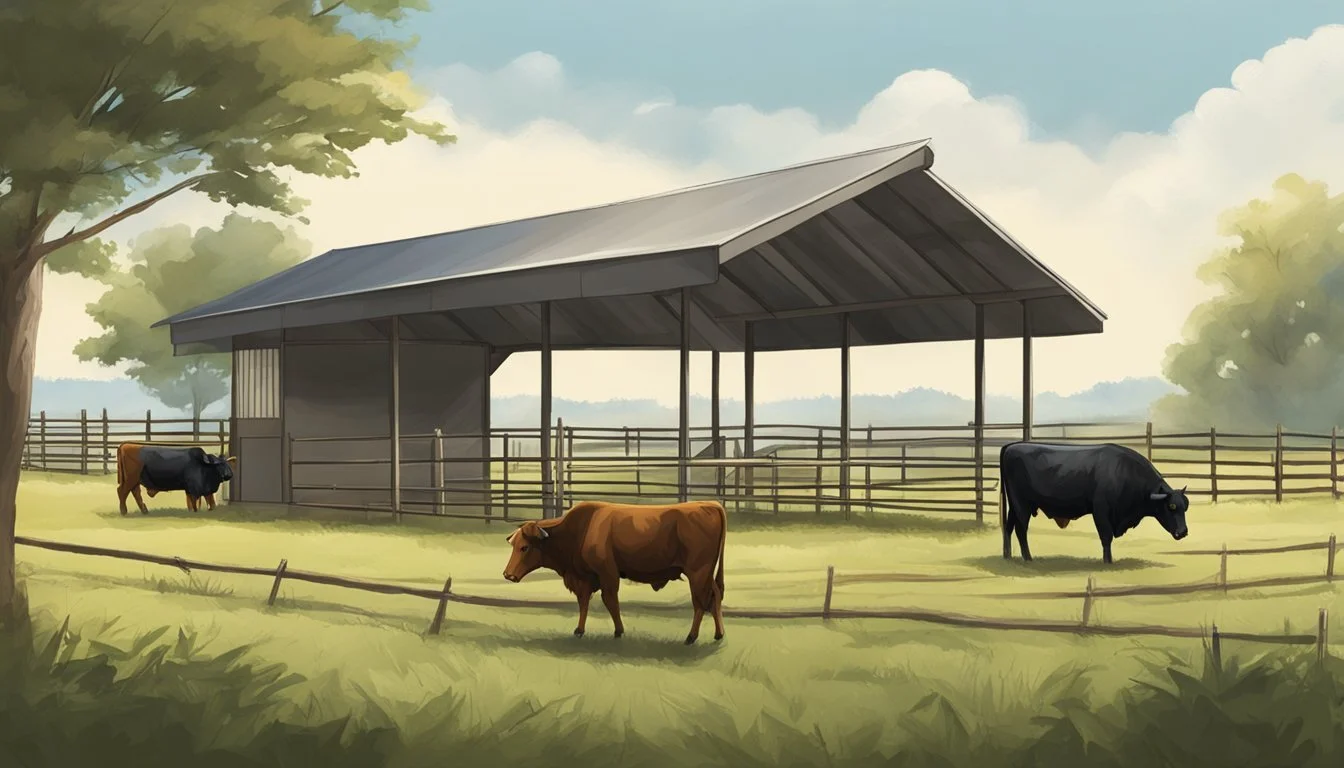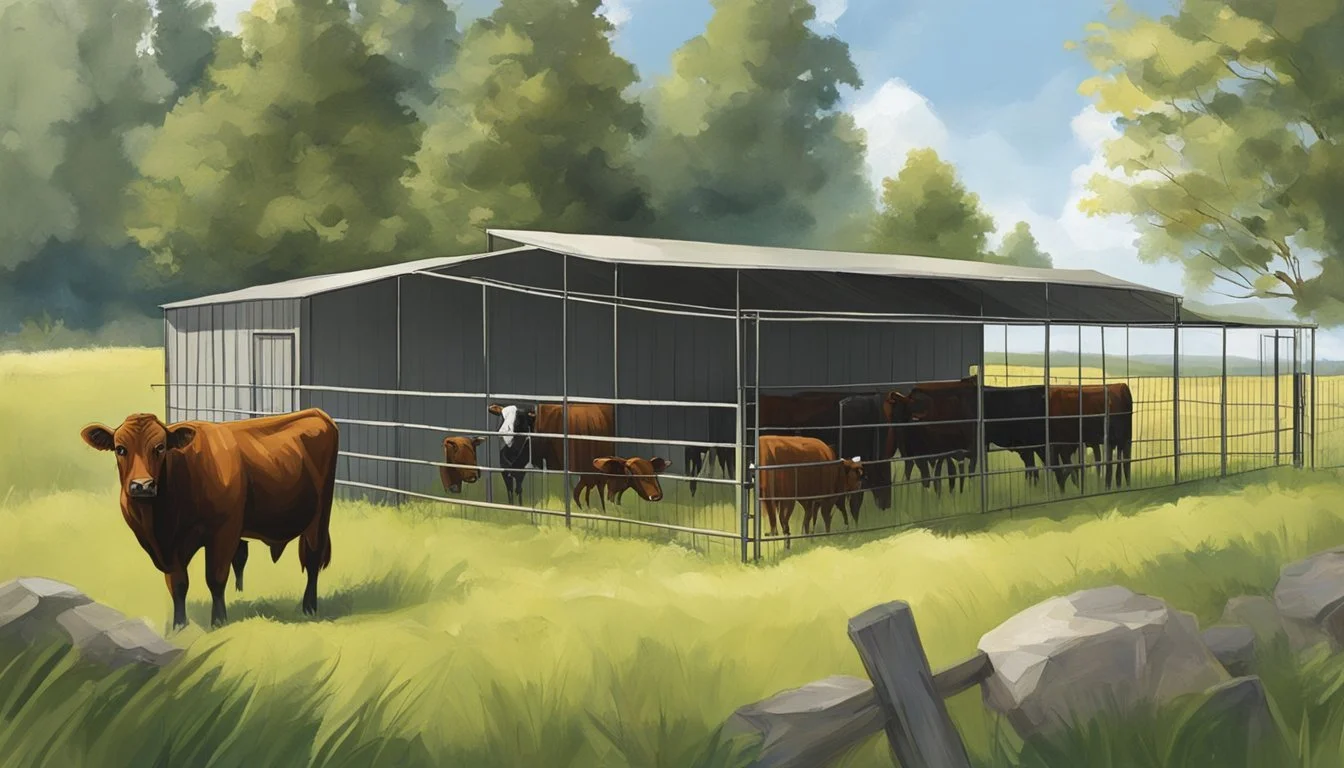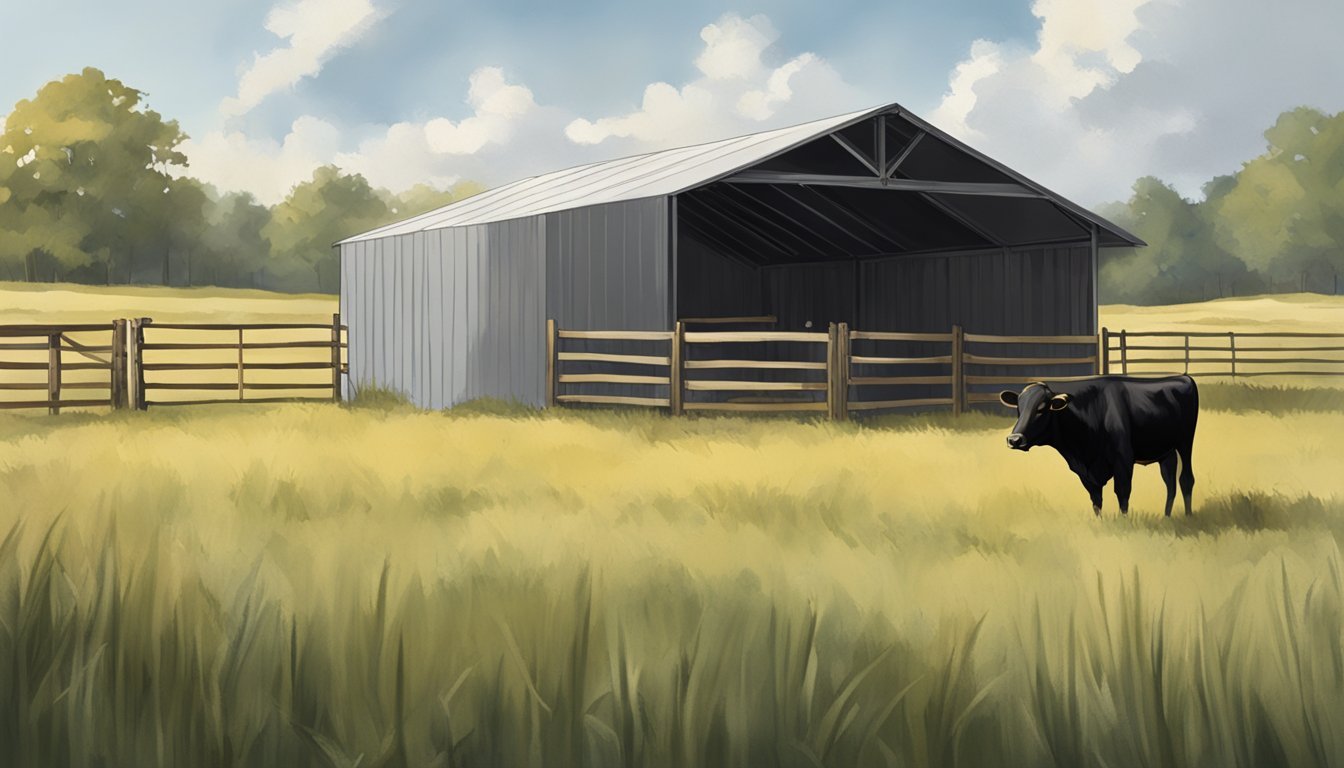Fencing and Shelter for Dexter Cattle
Essential Guidelines for Small-Scale Farms
Dexter cattle are an excellent option for small homesteads due to their manageable size, efficient food conversion, and dual-purpose nature for both milk and meat production. Establishing appropriate fencing and shelter for these miniature cattle is crucial to ensure their safety, comfort, and the overall efficiency of farm operations. Best practices for housing and managing Dexter cattle include considerations about the durability and height of fencing, as well as the design and location of shelter that fits the specific needs of this breed.
When it comes to fencing, Dexters require a secure perimeter that prevents escape and protects them from predators. Electric fencing is often recommended for its effectiveness and adaptability to various terrains encountered on small homesteads. Alternatively, sturdy materials like wood or cattle panels can be used, but farmers should account for the breed's smaller stature when determining the appropriate fence height and strength. Shelter for Dexter cattle should provide ample space for the animals to rest and find refuge from extreme weather conditions, ensuring a dry and well-ventilated environment to promote their health and well-being.
In implementing these structures, small homestead owners must balance their resources with the needs of Dexter cattle. By following best practices, farmers can create a sustainable and humane environment that optimizes the productivity and contentment of their Dexter herd. These considerations are not only investments in the cattle's quality of life but also in the long-term viability and success of the homestead.
Understanding Dexter Cattle
Before delving into specifics, it's essential to acknowledge that Dexter cattle are a unique small-sized breed known for their versatility and docile temperament. They serve as an excellent option for small homesteads due to their manageable size and amiable nature.
Origins and History
Dexter cattle originated in Ireland and can be traced back to the early 1800s. The breed was developed for its dual-purpose traits, useful for both milk and meat production. Dexter cattle were officially recognized as a breed in the late 19th century, and the first herd book was established in 1892 in Ireland. They have since spread to other parts of the world as a favored breed for small-scale farmers.
Physical Characteristics
Dexter cattle exhibit distinctive physical traits that differentiate them from other breeds. They are notably smaller in size, which makes them ideal for smaller homesteads with limited space.
Size & Weight:
Adult Bulls: Typically stand around 38 to 44 inches at the shoulder and weigh between 1,000 to 1,200 pounds.
Adult Cows: Generally measure around 36 to 42 inches at the shoulder, weighing between 750 to 850 pounds.
Color: Their coats can come in three primary colors, which are black, red, and dun.
Horns: Dexters may be horned or polled (naturally without horns). When horned, they have a moderate curve.
Unique Traits: Often have white markings, mainly in the form of a small star on the forehead, although they are primarily solid in color.
Behavior and Temperament
The temperament of Dexter cattle is one of their most prized characteristics. They are known for being docile and easy to handle, which contributes to their charm and affability.
Docility: Their docile temperament makes them easy for handlers to manage, especially beneficial for those new to raising cattle.
Behavioral Traits: They are hardy, adaptable, and generally exhibit calm dispositions, making them suitable for different climates and conditions.
The breed's combination of size, behavior, and dual-purpose traits contribute to its high desirability among small-scale farmers and homesteaders. Dexter cattle serve as an exemplary model of how a smaller breed can be both productive and compatible with homesteading life.
Housing and Shelter
Providing appropriate housing and shelter for Dexter cattle is crucial for their well-being, especially in diverse climates and weather conditions. This section details the shelter needs for Dexters and explains how best to design and maintain these structures.
Shelter Requirements
Dexter cattle require a basic but sturdy shelter to protect them from extreme weather. The space should be enough to allow each cow room to rest and move about comfortably. Essential features of an adequate shelter include:
Protection from Elements: The shelter must shield the cattle from wind, rain, snow, and excessive sun.
Ventilation: Proper airflow is necessary to keep the environment inside the shelter dry and comfortable.
Accessibility: Dexter cattle shelters should be easily accessible for the cattle as well as for homesteaders during feeding and routine care.
In temperate regions, a three-sided structure can suffice, whereas in colder climates, a more enclosed space may be necessary to provide adequate winter protection.
Design and Maintenance
Designing a shelter for Dexter cattle involves consideration of both the animals' needs and sustainable practices. Here's how to align design and maintenance for longevity and comfort:
Size and Space: Calculate about 40-50 square feet per animal to prevent overcrowding.
Materials: Durable materials like wood or metal that can withstand local weather conditions are recommended. Recycled materials can also be considered to manage costs and be more sustainable.
Maintenance Routine: Regular inspections and upkeep of the shelter are vital to ensure it remains safe and functional. This includes repairing any damage, managing manure, and making seasonal adjustments as needed.
By following these guidelines, homesteaders can provide Dexter cattle with a shelter that is both cost-effective and conducive to their health and productivity.
Fencing and Pasture Management
Effective fencing and pasture management are essential for optimizing the health and productivity of Dexter cattle on small homesteads. These components ensure the efficient use of space, appropriate grazing, and sustainable foraging practices.
Fencing Fundamentals
When enclosing pastures for Dexter cattle, it's important to choose materials that offer both security and durability. Consider the following considerations for constructing reliable fences:
Dimensions: Dexter cattle are smaller than many other breeds, so fencing should be at least 48 inches high to prevent them from jumping over.
Materials: Woven wire fencing with wood and steel uprights every 8 feet is recommended. Adding a strand of barbed wire at the top can enhance containment, especially in areas with diverse wildlife.
Electric Netting: For rotational grazing schemes, consider using 42-inch electric netting. This allows for flexible paddock setups within larger pastures and aids in managing grass regrowth.
Regular Maintenance: Inspect fences regularly for any signs of damage or wear, ensuring that boundaries remain secure against both cattle breakout and potential predators.
Grazing and Land Management
Implementing strategic grazing and land management practices is pivotal for maintaining pasture health and ensuring a consistent feed supply:
Rotational Grazing: This practice involves dividing the pasture into sections, or paddocks, and rotating livestock between them. It gives grass time to recover and can improve soil health. Here's a basic rotational plan:
Paddock Number: 1, Grazing Duration: 7 days, Rest Period: 21 days
Paddock Number: 2, Grazing Duration: 7 days, Rest Period: 21 days
Paddock Number: 3, Grazing Duration: 7 days, Rest Period: 21 days
Paddock Number: 4, Grazing Duration: 7 days, Rest Period: 21 days
Forage Quality: Ensure a mix of grasses in the pasture to maximize nutrition and palatability. Grass varieties like ryegrass, clover, and fescue can provide a balanced diet for Dexter cattle.
Sustainable Grass Growth: Maintain the pasture by seeding, fertilizing, and managing pests as needed. This ensures sustainable forage production and a healthy feeding ground for the livestock.
Space and Livestock Density: Avoid overstocking. Each Dexter cow requires about 1.5 to 2 acres of quality pasture to graze efficiently without degrading the land.
Implementing these measures in fencing and pasture management helps in creating a sustainable and productive environment for Dexter cattle on small homesteads.
Feeding and Nutrition
Dexter cattle, known for their adaptability to various environments, require a diet that sustains their health and accommodates their grass-fed beef production. The focus on proper feeding and nutrition is paramount in ensuring the health and productivity of the herd.
Dietary Requirements
Dexter cattle thrive on a grass-based diet, making pasture the centerpiece of their nutritional intake. These cattle do well on smaller acreages with high-quality forage; a well-maintained pasture can often meet their needs. They are ruminants, requiring a diet rich in fibers, primarily sourced from grasses. To meet their needs, owners may allocate approximately one to two acres per head, ensuring the forage is dense and plentiful. During the winter months or times when pastures are not lush, additional hay must be provided to maintain their condition. The amount and quality of hay are critical—good quality hay should be free of dust and mold and have a high nutritional value.
Feed Type: Pasture, Amount: 1-2 acres/head, Notes: Sufficient for grazing
Feed Type: Hay, Amount: Variable, Notes: Provide during winter; high quality
Feed Type: Grain, Amount: Supplementary, Notes: If required for nutritional balance
Supplements and Treats
While grass-fed regimes are central to Dexter cattle nutrition, some situations necessitate supplementary grains like corn to meet energy requirements or address nutritional deficits. These supplements should be provided cautiously to avoid excessive weight gain or health issues related to overfeeding. Grain supplements might be particularly beneficial when pasture quality is low or for high-producing cows that require more energy, such as lactating mothers.
Protein blocks or mineral supplements can also be offered to ensure a balanced intake of nutrients, especially in regions where the soil might be deficient in certain minerals. Treats can include:
Specific fruits and vegetables in moderation
Specially-formulated cattle treats
These should be administered sparingly to prevent digestive upsets and to not disturb the balance of their primary diet. It's important to consult with a livestock nutritionist or veterinarian to create a feeding regime that supports optimal health and production, especially for those aiming to produce quality milk or beef cuts from their Dexter cattle. The benefits of well-managed nutrition include improved overall health, better reproductive performance, and superior quality dairy and beef products.
Health and Care
Dexter cattle's health and care are pivotal in ensuring they thrive and reach their potential lifespan. A robust health care routine contributes to their renowned hardiness and adaptability. This section covers the vital elements of routine health checks and identifies common health challenges along with their treatments.
Routine Health Checks
Routine health checks are essential in maintaining the health of Dexter cattle. They should include:
Body Condition Scoring: Regular assessments to ensure optimal weight and health status.
Parasite Control: Fecal exams and deworming as needed to prevent internal parasitic infections.
Hoof Care: Examination and trimming to prevent lameness issues.
Vaccinations: Adhering to a vaccination schedule to prevent common bovine diseases.
Common Issues and Treatments
Despite their hardiness, Dexter cattle can face health challenges.
Chondrodysplasia: A genetic disorder they are predisposed to that affects bone growth.
Monitoring: Breeders should screen for the gene to manage its presence in the population.
Respiratory Infections: Can occur, especially in poorly ventilated shelters.
Ventilation Improvement: Ensures proper airflow in housing facilities.
Antibiotic Treatment: Administered as prescribed by a veterinarian for bacterial infections.
Caring for Dexter cattle's health ensures they live fulfilling lives and remain a resilient addition to small homesteads.
Breeding and Calving
In the context of small homesteads, the breeding and calving of Dexter cattle require diligent reproductive management to ensure healthy offspring and maintain the breed’s esteemed characteristics. Both breeding and calving procedures are pivotal to safeguard the vitality of the herd and the well-being of both cows and calves.
Reproductive Management
Successful breeding practices hinge on understanding the Dexter cattle's reproductive cycle and ensuring the use of a docile, well-conformed bull. Dexter bulls are known for their longevity and can typically service cows for many years. It’s essential to record the breeding date, as gestation in Dexter cattle averages around 283 days, with a usual variance of 10 days before or after the due date.
Breeding Practices:
Monitor heat cycles: Regularly observe and document the cow’s heat signs to time the breeding accurately.
Bull health: Regularly assess the bull’s health and fertility to maintain effective breeding.
Breeding records: Keep meticulous records of each breeding to predict calving dates and manage the herd’s genetic diversity.
Calving Procedures and Care
Calving in Dexter cattle generally proceeds smoothly due to the breed's calving ease, but preparatory steps and vigilant care can avert complications. Any deviations from normal delivery should prompt immediate veterinary attention.
Calving Practices:
Prepare a clean, safe environment: A well-bedded, draft-free calving area helps to ensure a healthy delivery.
Observe closely: As the expected calving date nears, monitor the cow for signs of labor, while minimizing stress.
Post-calving care: Once the calf is born, ensure it is breathing properly and ingesting colostrum within the first few hours for vital antibodies.
Practitioners of these practices ensure the sustainability and prosperity of both the animals and the homestead.
Utilization of Dexter Cattle
Dexter cattle serve as an economical choice for small homesteads, providing high-quality beef and milk products. Homesteaders value their adaptability, efficient meat and dairy production, and the advantages of being a dual-purpose breed.
Meat Production
Dexter cattle are renowned for the quality of their beef. With appropriate care, they yield meat with good marbling, which contributes to the beef's tenderness and flavor. Homesteaders can expect a moderate stock size from Dexters, usually offering a substantial meat output, ideal for personal consumption or local marketing.
Beef Characteristics:
Marbling: Good
Tenderness: High
Flavor: Rich
Dairy Production
In terms of dairy, Dexters are prolific milk producers, despite their compact size. Their milk output is typically rich in butterfat and cream, making it suitable for cheese and other dairy products. The milk's high butterfat content allows homesteaders to create quality homemade butter and cream-based foods.
Milk Output:
High in Butterfat
Ideal for Cream and Cheese Production
Sufficient for small-scale farming needs
Dual-Purpose Advantage
Dexters exemplify the versatility needed for successful small-scale homesteading. As a dual-purpose breed, they offer an economical solution for meat and milk production on the same homestead. They effectively provide families with essential dairy products, while also contributing to the homestead's meat supply.
Advantages:
Economical: Reduces the need for separate meat and dairy herds
Versatile: Suits various homesteading requirements
Dual Output: Offers both milk and beef from the same animal
Environmental Considerations
When setting up fencing and shelter for Dexter cattle, small homesteads must prioritize the use of land and sustainable practices to ensure both the health of the cattle and the long-term viability of the homestead.
Land and Resource Use
In terms of land utilization, Dexter cattle are advantageous for small homesteads with limited space. These cattle require less land than conventional cattle breeds, thriving in various climates from temperate to more extreme weather conditions. For optimal grass growth, a sustainable homestead should assess the following:
Climate Impact on Pasture: Different climates will affect the types of grasses that can be cultivated and how well they grow.
Stock Density: A higher stock density in smaller spaces may necessitate rotational grazing to maintain grass health and availability.
A brief comparison between Dexter cattle and conventional breeds in terms of space requirements could be illustrated as follows:
Breed Type: Dexter Cattle, Average Space Needed per Animal: 0.5 to 1 acre
Breed Type: Conventional Breeds, Average Space Needed per Animal: 1.5 to 2 acres
Sustainable Practices
Sustainable practices for fencing and shelter focus on minimizing environmental impact while ensuring the wellbeing of Dexter cattle. Key components include:
Shelter Design: Shelters should provide protection from extreme weather while using sustainable, locally sourced materials where possible.
Water Conservation: Clean water should be accessible, and methods to reduce water waste, such as rainwater collection systems, can be implemented.
Grazing Management: Implementing a rotational grazing system not only supports grass regeneration but also aids in soil conservation and prevents overgrazing.
A homesteader must consider the entire ecosystem, ensuring that their Dexter cattle contribute positively to their environment. This includes:
Preserving local biodiversity by avoiding overgrazing.
Using fencing materials that are durable and have minimal environmental impact.
In managing a small homestead, these environmental considerations not only support the health and productivity of Dexter cattle but also foster a sustainable and responsible agricultural practice.
Economic Aspects and Marketing
In the landscape of small homesteads, economic viability and effective marketing strategies are crucial for the successful raising and selling of Dexter cattle.
Cost-Benefit Analysis
For small farms, it's essential to conduct a Cost-Benefit Analysis to ensure the economic sustainability of raising Dexter cattle. Costs include initial livestock purchase, fencing, shelter construction, feed, veterinary care, and general maintenance. Meanwhile, the economic benefits for small homesteads often come from the sale of meat, milk, and breeding stock. Dexter cattle are a cost-effective choice due to their smaller size, which requires less feed and space compared to larger breeds. Their price ranges approximately from $2,500 to $3,000 for beef cows and around $900 to $3,000 for dairy cows, depending on market conditions.
Initial Expenses:
Livestock Purchase: $900 - $3,000 per animal
Fencing and Shelter: Varies, but essential for protection and health
Feed: Pasture-based and grain supplementation
Potential Revenue:
Meat Sales: Variable but premium prices for quality Dexter beef
Milk Production: Niche market for dairy products
Breeding Stock: Selling calves or mature cattle
This analysis helps homesteaders understand the potential return on investment and devise budgets that align with their financial capacity.
Marketing Strategies
Effective marketing strategies are paramount for small farms to create demand and sell their livestock at profitable prices. A crucial aspect of marketing Dexter cattle is highlighting their unique traits: their versatility, hardiness, and the superior quality of their meat which is often considered delicious. Educating the consumers on the benefits of Dexter cattle products can help in carving out a niche in a crowded market.
Direct Sales: Selling meat and dairy products directly to consumers at farmers' markets or through Community Supported Agriculture (CSA).
Online Marketing: Leveraging social media and farm websites to reach a broader audience.
Agritourism: Inviting the public to visit the farm for educational tours can build a loyal customer base.
Word of Mouth: Encouraging satisfied customers to share their experiences.
By owning the narrative and proactively reaching out to potential customers, small homesteaders can avoid undervaluation and ensure financial returns that justify their investment in Dexter cattle.
Community and Associations
Engaging with fellow homesteaders and associations can lead to shared knowledge and enhanced support, both of which are crucial for small farm operations that focus on raising Dexter cattle.
Networking with Other Homesteaders
Connecting with other farmers and homesteaders provides a valuable exchange of practical advice on managing Dexter cattle. These connections can be forged through:
Local farming groups: These may offer opportunities for resource sharing and joint marketing efforts.
Social media platforms: Online communities and forums are platforms for discussion about best practices and problem-solving.
Informal gatherings: Events and field days serve as platforms to meet and learn from experienced Dexter cattle keepers.
Key benefits include the collective wisdom on suitable fencing options and insights into effective shelter configurations for Dexters.
Leveraging Associations for Support
Associations such as the American Dexter Cattle Association (ADCA) are instrumental for small farm owners. They provide:
Breed standards: Clearly outlined expectations for Dexter cattle care and breeding.
Educational resources: Guidance on best practices for raising healthy Dexter cattle.
Event information: Information on shows and competitions to showcase Dexter cattle and network with other farmers.
Support networks: Access to a community of Dexter cattle enthusiasts for advice and problem-solving.
Membership with organizations like the ADCA can also aid in marketing efforts, helping to connect farmers with potential buyers within the community.








